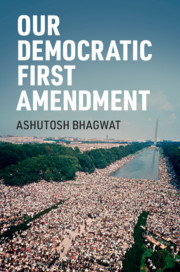Book contents
- Our Democratic First Amendment
- Our Democratic First Amendment
- Copyright page
- Dedication
- Contents
- Acknowledgments
- Introduction
- Part I The Framers’ Democratic First Amendment
- Part II The Democratic First Amendment in the Age of Twitter
- 5 Cacophony: Speech and Press in the Internet Era
- 6 DeSiloing: Of Civic Associations, Book Clubs, and Taverns
- 7 Why Assembly and Petition Still Matter
- Conclusion
- Index
7 - Why Assembly and Petition Still Matter
from Part II - The Democratic First Amendment in the Age of Twitter
Published online by Cambridge University Press: 28 May 2020
- Our Democratic First Amendment
- Our Democratic First Amendment
- Copyright page
- Dedication
- Contents
- Acknowledgments
- Introduction
- Part I The Framers’ Democratic First Amendment
- Part II The Democratic First Amendment in the Age of Twitter
- 5 Cacophony: Speech and Press in the Internet Era
- 6 DeSiloing: Of Civic Associations, Book Clubs, and Taverns
- 7 Why Assembly and Petition Still Matter
- Conclusion
- Index
Summary
Chapter 7 discusses the continuing relevance and importance of the assembly and petition rights in the modern, online era. Regarding assembly, it notes that large gatherings of citizens such as the 2017 Women’s March (modeled on the 1963 March on Washington lead by Dr. Martin Luther King, Jr.) continue to play a critical role in enabling ordinary citizens to participate in democratic governance. Even in the Internet era, physical assemblies have a unique ability to express the strength and popularity of political positions, as well as to galvanize the participants in such events. The Internet has for that reason not displaced physical assembly, though it has simplified the organizing of such assemblies and permitted individuals who cannot physically assemble to jointly develop and express shared views. The chapter also explores and criticizes legal barriers to the exercise of assembly rights. Finally, the chapter argues in favor of reviving the traditional right of petition, and in particular the use of physical, hand-delivered petitions as a means to restore contact between citizens and public officials. It closes by demonstrating how the 1965 Selma March illustrates the continuing value of assembly and petition in our democracy.
Keywords
- Type
- Chapter
- Information
- Our Democratic First Amendment , pp. 140 - 159Publisher: Cambridge University PressPrint publication year: 2020

